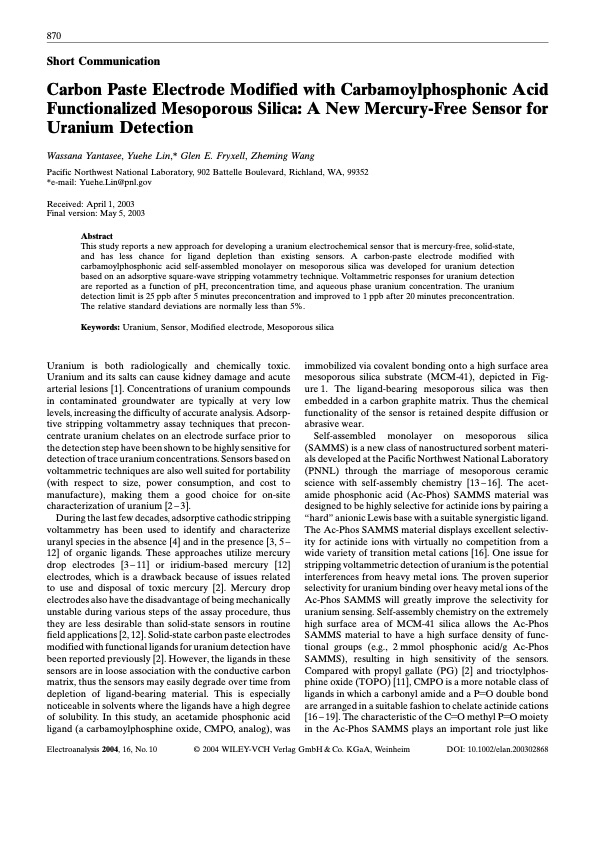
PDF Publication Title:
Text from PDF Page: 001
870 Short Communication Carbon Paste Electrode Modified with Carbamoylphosphonic Acid Functionalized Mesoporous Silica: A New Mercury-Free Sensor for Uranium Detection Wassana Yantasee, Yuehe Lin,* Glen E. Fryxell, Zheming Wang Pacific Northwest National Laboratory, 902 Battelle Boulevard, Richland, WA, 99352 *e-mail: Yuehe.Lin@pnl.gov Received: April 1, 2003 Final version: May 5, 2003 Abstract This study reports a new approach for developing a uranium electrochemical sensor that is mercury-free, solid-state, and has less chance for ligand depletion than existing sensors. A carbon-paste electrode modified with carbamoylphosphonic acid self-assembled monolayer on mesoporous silica was developed for uranium detection based on an adsorptive square-wave stripping votammetry technique. Voltammetric responses for uranium detection are reported as a function of pH, preconcentration time, and aqueous phase uranium concentration. The uranium detection limit is 25 ppb after 5 minutes preconcentration and improved to 1 ppb after 20 minutes preconcentration. The relative standard deviations are normally less than 5%. Keywords: Uranium, Sensor, Modified electrode, Mesoporous silica Uranium is both radiologically and chemically toxic. Uranium and its salts can cause kidney damage and acute arterial lesions [1]. Concentrations of uranium compounds in contaminated groundwater are typically at very low levels, increasing the difficulty of accurate analysis. Adsorp- tive stripping voltammetry assay techniques that precon- centrate uranium chelates on an electrode surface prior to the detection step have been shown to be highly sensitive for detection of trace uranium concentrations. Sensors based on voltammetric techniques are also well suited for portability (with respect to size, power consumption, and cost to manufacture), making them a good choice for on-site characterization of uranium [2 ± 3]. During the last few decades, adsorptive cathodic stripping voltammetry has been used to identify and characterize uranyl species in the absence [4] and in the presence [3, 5 ± 12] of organic ligands. These approaches utilize mercury drop electrodes [3 ± 11] or iridium-based mercury [12] electrodes, which is a drawback because of issues related to use and disposal of toxic mercury [2]. Mercury drop electrodes also have the disadvantage of being mechanically unstable during various steps of the assay procedure, thus they are less desirable than solid-state sensors in routine field applications [2, 12]. Solid-state carbon paste electrodes modified with functional ligands for uranium detection have been reported previously [2]. However, the ligands in these sensors are in loose association with the conductive carbon matrix, thus the sensors may easily degrade over time from depletion of ligand-bearing material. This is especially noticeable in solvents where the ligands have a high degree of solubility. In this study, an acetamide phosphonic acid ligand (a carbamoylphosphine oxide, CMPO, analog), was immobilized via covalent bonding onto a high surface area mesoporous silica substrate (MCM-41), depicted in Fig- ure1. The ligand-bearing mesoporous silica was then embedded in a carbon graphite matrix. Thus the chemical functionality of the sensor is retained despite diffusion or abrasive wear. Self-assembled monolayer on mesoporous silica (SAMMS) is a new class of nanostructured sorbent materi- als developed at the Pacific Northwest National Laboratory (PNNL) through the marriage of mesoporous ceramic science with self-assembly chemistry [13 ± 16]. The acet- amide phosphonic acid (Ac-Phos) SAMMS material was designed to be highly selective for actinide ions by pairing a TMhard∫ anionic Lewis base with a suitable synergistic ligand. The Ac-Phos SAMMS material displays excellent selectiv- ity for actinide ions with virtually no competition from a wide variety of transition metal cations [16]. One issue for stripping voltammetric detection of uranium is the potential interferences from heavy metal ions. The proven superior selectivity for uranium binding over heavy metal ions of the Ac-Phos SAMMS will greatly improve the selectivity for uranium sensing. Self-assembly chemistry on the extremely high surface area of MCM-41 silica allows the Ac-Phos SAMMS material to have a high surface density of func- tional groups (e.g., 2 mmol phosphonic acid/g Ac-Phos SAMMS), resulting in high sensitivity of the sensors. Compared with propyl gallate (PG) [2] and trioctylphos- phine oxide (TOPO) [11], CMPO is a more notable class of ligands in which a carbonyl amide and a PO double bond are arranged in a suitable fashion to chelate actinide cations [16 ± 19]. The characteristic of the CO methyl PO moiety in the Ac-Phos SAMMS plays an important role just like Electroanalysis 2004, 16, No. 10 1 2004 WILEY-VCH Verlag GmbH & Co. KGaA, Weinheim DOI: 10.1002/elan.200302868PDF Image | Carbon Paste Electrode Modified with Carbamoylphosphonic

PDF Search Title:
Carbon Paste Electrode Modified with CarbamoylphosphonicOriginal File Name Searched:
Carbon-Paste-Electrode.pdfDIY PDF Search: Google It | Yahoo | Bing
Salgenx Redox Flow Battery Technology: Salt water flow battery technology with low cost and great energy density that can be used for power storage and thermal storage. Let us de-risk your production using our license. Our aqueous flow battery is less cost than Tesla Megapack and available faster. Redox flow battery. No membrane needed like with Vanadium, or Bromine. Salgenx flow battery
| CONTACT TEL: 608-238-6001 Email: greg@salgenx.com | RSS | AMP |